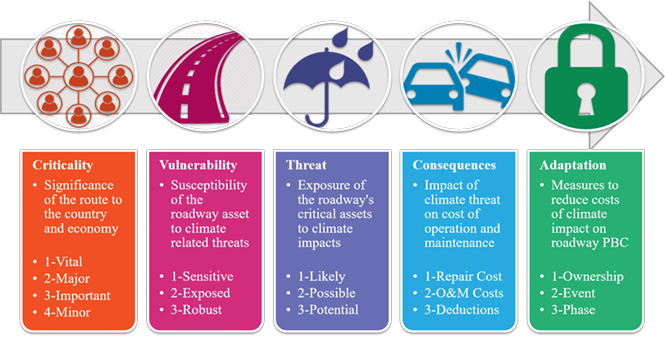
Output and performance based road contracts (OPRC) is a contracting modality that is increasingly being used to help manage roads. Unlike traditional contracts, where the owners define what is to be done, and oftentimes how to do it, OPRC contracts define the outcome that the owners want to achieve, and the contractor is responsible to meet those outcomes. Performance is measured against a series of key performance indicators (KPIs) or service levels.
Critical to the success of any OPRC contract is the assignment of risk between parties. Climate change has major implications for OPRC contracts because it affects the risk exposure of both parties. With funding from the Public Private Infrastructure Advisory Facility (PPIAF), a new analysis considered how to incorporate climate change risks into OPRC contracts.
What’s Happening Right Now?
Without clear expectations around climate risk, neither the asset owner nor the companies bidding for performance contracts will adequately address the risks. Bidders cannot be held accountable for risks that are not specifically cited or linked with performance criteria.
At present, climate change risks are generally carried by the asset owner through the Force Majeure provisions of the contract, and treated as ‘unforeseen’ events, with repair costs reimbursed to the contractor. This impacts the overall cost of the OPRC, and where extreme weather events are becoming common-place, reduces the efficacy of OPRC as a contracting modality. The most pressing issues challenging stakeholders during each phase of development are summarized in this chart.
Each contracting party in OPRC faces unique threats and an obligation to mitigate the risk of those threats. The risk of climate change must be allocated to the contracting party best able to manage the impacts.
Our study proposes to estimate and allocate risks using the following 5 steps. Steps 1-3 influence the design and performance standards incorporated in the OPRC; they are the responsibility of the asset owner. Steps 4 - 5 fall under the purview of the contractor.
- Determine the criticality of the asset. Considering location, usage, classification, redundancy, economic and social importance, and what infrastructure is present (i.e. other services).
- Determine its vulnerability. Which climate-related hazards are most likely to impact the asset, and which adaptation measures will provide the most value and risk mitigation over time? Consider geometry, terrain and geology, components (e.g. tunnels, bridges), materials, and drainage.
- Determine the climate threat. Existing global climate models can help determine the future climate exposure and the associated design parameters required.
- Determine the Consequences. Consequences addressed by the contractor include repair costs, operational costs, and KPI deductions based on the risk level defined in Steps 1, 2, and 3.
- Adaptation measures. Based on future climate projections, as determined by steps 1, 2, and 3, the contractor will identify the right design parameters to build back better.

At an operational level, the following recommendations can help address the risk of climate change in OPRC projects, and improve the allocation of risk and cost effectiveness of the project:
- Include budgets and performance metrics for climate risk and resilience.
- Clearly define the timing horizons, as this directly impacts climate projections. Further, given the long OPRC contract periods, consider a climate resilience index for cost escalation;
- On the basis of risk allocations, realistically estimate potential emergency works.
- Consider excessive cost overruns associated with recovery from climate-induced extreme events as part of the history of non-performing contracts.
- Explicitly require climate adaptation expertise as key personnel skills for both the contractor and asset owner.
- Incentivize proactive resilience measures by including resilience criteria in OPRC bid evaluation.
- Ensure specifications mandate the use of climate projections to inform the design storm parameters.
- Require the asset owner’s Environmental and Social policy to detail how climate risks will impact the project.
- During OPRC implementation, ensure contractors provide asset owners with the maintenance history, as a means to identify trends in climate-change risks, so that increasingly accurate resilience considerations are addressed in future bids.
- Training and awareness. Governments and asset owners need to be better informed about the potential impact of climate change on transport investments so they can give these risks the attention they deserve.
- Return on resilience investment. Conservative global climate models with long range time horizons may result in cost-prohibitive construction estimates for adaptation measures. Cost-benefit analysis on different options is essential.
- Climate risk in credit rating. Credit and insurance ratings may undervalue climate risk exposure and consequently de-emphasize the effectiveness of climate adaptation efforts.
- Extending investment periods. Contracts with terms of seven years or less do not incentivize long-term climate change risk mitigation and adaptation.
Acknowledgments
The authors acknowledge the work of Arup Advisory Inc. on the PPIAF-financed project ‘Incorporating Climate Adaptation Risks to Performance Based Contracting,’ which forms the basis for this blog. We are grateful for the support of PPIAF as well as colleagues at the World Bank and Asian Development Bank in undertaking the work.
Learn more
Explore the full report: Incorporating Climate Adaptation Risks to Performance Based Contracting
- Inception report
- State of the Industry Review
- Risk Management Framework
- Performance Metrics
- Contracting Recommendations



Join the Conversation